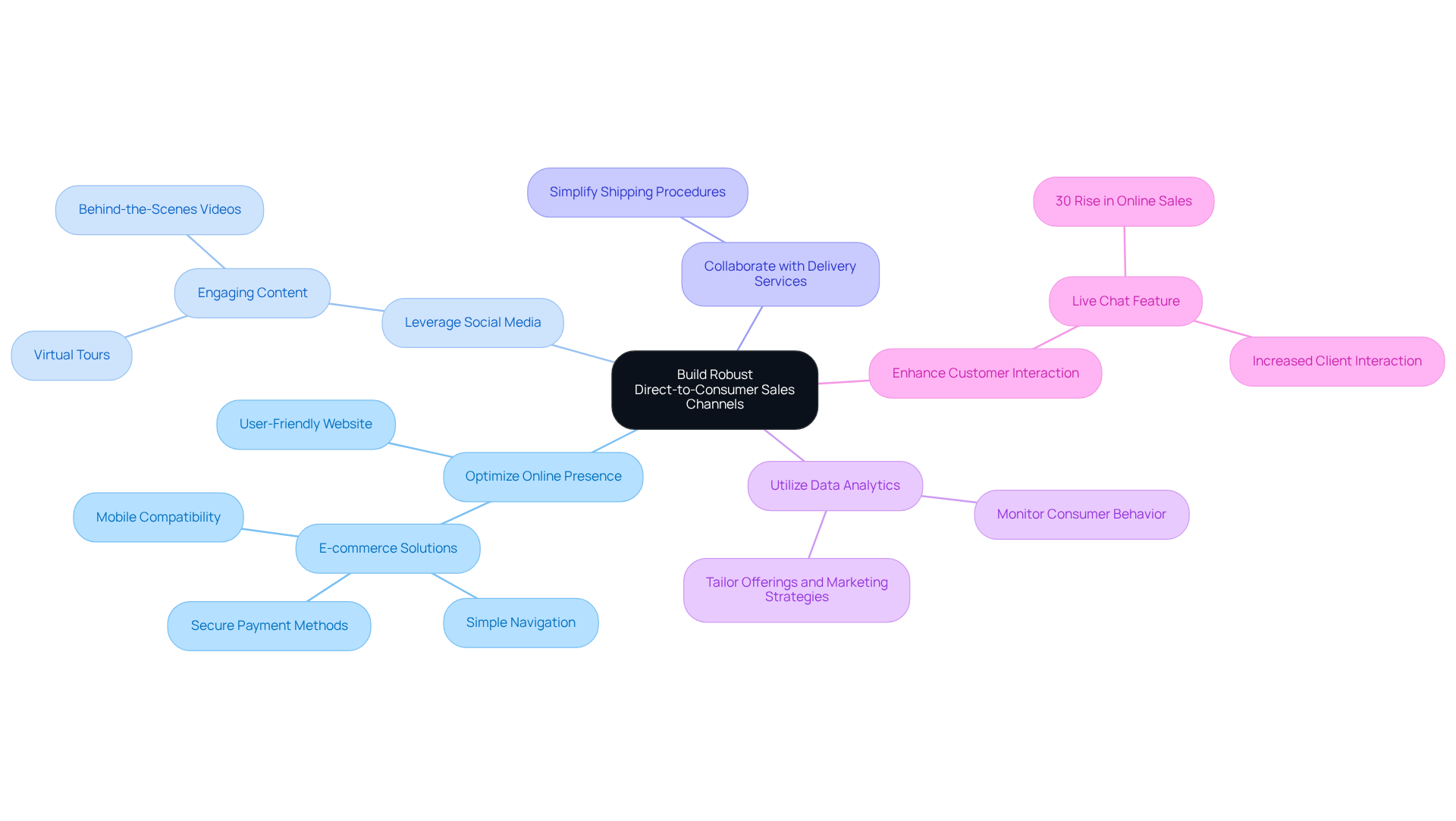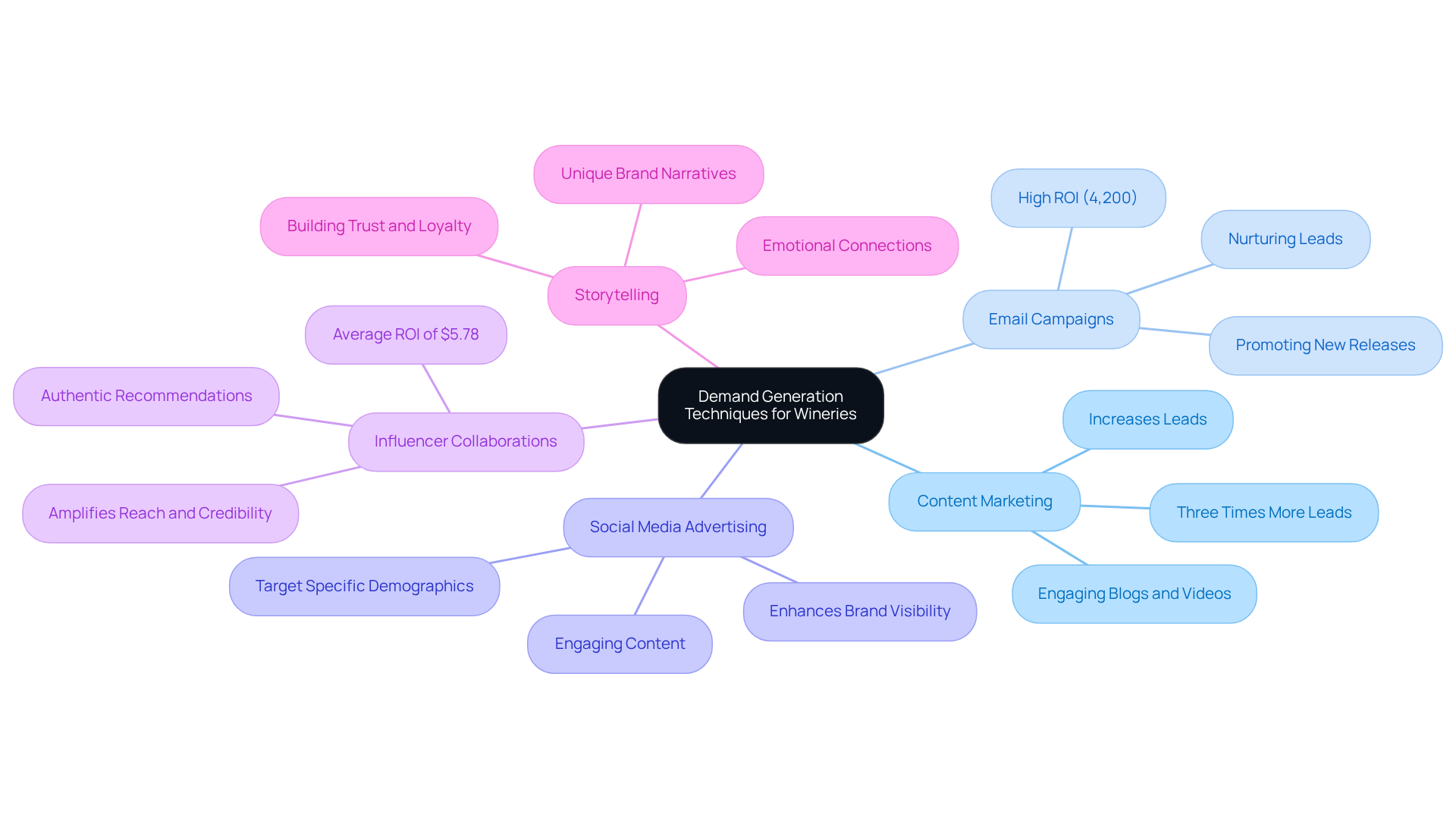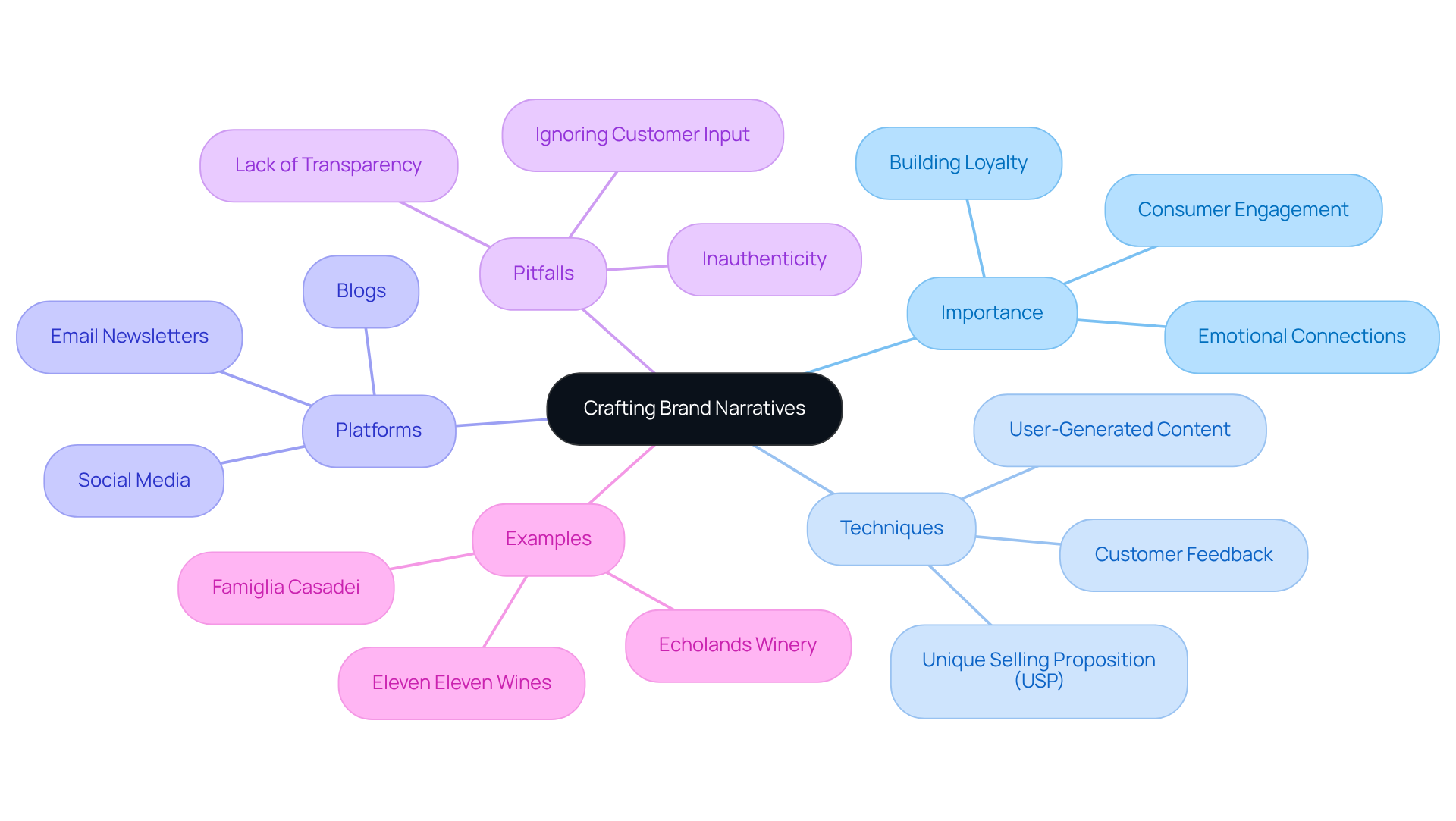Overview
This article presents four proven strategies designed to enhance direct sales growth for Napa Valley wineries. It emphasizes the importance of:
- Optimizing online sales channels
- Improving wine club memberships
- Implementing effective demand generation techniques
- Crafting compelling brand narratives
Each strategy is underpinned by practical examples and data. For instance, a user-friendly website and personalized experiences for wine club members are critical, demonstrating how these approaches can significantly drive consumer engagement and sales. By adopting these strategies, wineries can not only increase their market presence but also foster deeper connections with their customers, ultimately leading to sustained growth.
Introduction
In the competitive landscape of Napa Valley, wineries are increasingly adopting innovative strategies to enhance their direct sales and engage consumers more effectively. This article explores four proven methods that can revolutionize how wineries connect with their audience, ranging from optimizing online sales channels to crafting compelling brand narratives. Yet, in a market brimming with options, how can wineries discern the most effective approaches to not only attract but also retain loyal customers in an ever-evolving environment?
Build Robust Direct-to-Consumer Sales Channels
To establish strong Napa Valley winery direct sales channels, wineries must prioritize the optimization of their online presence. A user-friendly website is crucial; it serves as a platform to effectively showcase products from Napa Valley winery direct. Vital e-commerce solutions for Napa Valley winery direct must feature simple navigation, secure payment methods, and mobile compatibility to serve the increasing number of individuals shopping online.
How can wineries leverage social media to enhance their online sales? By driving traffic to their online store with engaging content, such as virtual tours and behind-the-scenes videos, Napa Valley winery direct can significantly enhance consumer interest and encourage purchases. A notable example is a Napa Valley winery direct that incorporated a live chat feature on its website, resulting in a 30% rise in online sales due to enhanced client interaction and support.
Furthermore, establishing collaborations with local delivery services can simplify shipping procedures for Napa Valley winery direct, greatly improving the overall client experience. Wineries in Napa Valley winery direct should also utilize to monitor consumer behavior, allowing them to tailor offerings and marketing strategies to align with the evolving preferences of their target audience. This data-driven strategy not only encourages customer loyalty but also enables Napa Valley winery direct to adapt swiftly to market changes. In this competitive landscape, the ability to respond to consumer needs with Napa Valley winery direct is not just an advantage; it is essential for sustained success.

Optimize Wine Club Memberships for Growth
To enhance wine club memberships, vineyards must prioritize the creation of unique and personalized experiences for their members. This involves:
- Providing exclusive access to limited-edition wines
- Customizing shipments to individual preferences
- Extending special invitations to vineyard events
A vineyard that implemented a tiered membership program, for instance, experienced a remarkable 40% increase in sign-ups by offering varying levels of benefits, including private tastings and merchandise discounts.
Regular communication is essential for maintaining member engagement. Newsletters and personalized emails keep members informed about upcoming releases and events, fostering a sense of community. Moreover, establishing a referral program can motivate current members to introduce new customers, further expanding the club's reach.
Monitoring member engagement and gathering feedback are critical for ongoing improvement. Wineries that actively track member preferences and adapt their offerings can significantly . By concentrating on personalized experiences and efficient communication methods, wineries can ensure their wine clubs remain appealing to both new and current members.
![]()
Implement Effective Demand Generation Techniques
Wineries can significantly enhance their demand generation efforts by employing a diverse array of . Content marketing is essential; producing informative blogs and engaging videos that explore wine production and tasting notes effectively attracts potential clients. Wineries that consistently share engaging material on their websites and social media platforms often experience a substantial increase in website visits and inquiries. Research indicates that businesses prioritizing content marketing generate three times more leads than those relying solely on traditional advertising.
In addition to content marketing, targeted email campaigns serve as a powerful tool for nurturing leads. By promoting new releases, special events, and exclusive offers, vineyards can effectively convert interested prospects into loyal patrons. The potential ROI of email marketing exceeds 4,200%, establishing it as a cost-effective strategy for maintaining consumer engagement.
Moreover, leveraging targeted advertising on social media platforms allows vineyards to reach specific demographics, thereby enhancing brand visibility. Collaborating with influencers within the wine industry can further amplify a winery's reach and credibility, driving additional traffic to napa valley winery direct channels. Influencer campaigns have been shown to deliver an average ROI of $5.78 for every dollar spent, underscoring their effectiveness in enhancing customer acquisition efforts. Furthermore, storytelling plays a vital role in the wine industry, as it helps establish emotional connections with customers, converting casual purchasers into dedicated club members and amplifying the overall effectiveness of these marketing strategies.

Craft Compelling Brand Narratives to Engage Consumers
Creating engaging brand stories is essential for vineyards aiming to forge deeper connections with consumers. This involves sharing the unique narrative behind the vineyard's establishment, encompassing its history, core values, and the individuals integral to the winemaking process. For instance, a vineyard that highlights its founding family's dedication to sustainable practices has successfully cultivated a loyal customer base that values authenticity and transparency.
To effectively convey these narratives, wineries should leverage diverse platforms such as social media, blogs, and email newsletters. This multi-channel strategy fosters a cohesive brand identity that resonates with customers. Engaging visuals, including videos and high-quality images, play a pivotal role in enhancing storytelling efforts, capturing the attention of potential customers.
Statistics indicate that brands with compelling narratives experience significantly higher consumer engagement. For example, Famiglia Casadei reported an 18% increase in conversion rates after employing predictive analysis tools to refine their storytelling strategies. By nurturing emotional connections through authentic narratives, vineyards can stimulate repeat purchases and cultivate a community of brand advocates.
Effective narrative techniques center on the establishment's unique selling proposition (USP), such as artisanal quality or innovative production methods. Furthermore, incorporating user-generated content and soliciting customer feedback can enrich the brand narrative, rendering it more relatable and engaging.
To bolster these storytelling initiatives, wine producers must prioritize securing adequate capital for their growth strategies. This encompasses strategic capital planning to ensure they possess the necessary resources to effectively enhance their napa valley winery [direct-to-consumer channels](https://enocap.com).
However, they must remain vigilant against common pitfalls in storytelling, such as failing to uphold transparency or authenticity, which can erode trust among their audience. Ultimately, a not only distinguishes a napa valley winery direct in a competitive market but also fosters enduring relationships with consumers, driving predictable DTC revenue and nurturing loyalty.

Conclusion
Establishing effective direct sales growth strategies for Napa Valley wineries requires a multifaceted approach that prioritizes both consumer engagement and operational efficiency. By optimizing online sales channels, enhancing wine club memberships, implementing targeted demand generation techniques, and crafting compelling brand narratives, wineries can significantly boost their direct-to-consumer sales.
Key strategies include:
- The necessity of a user-friendly online presence
- The value of personalized wine club experiences
- The power of digital marketing and storytelling in attracting and retaining customers
Wineries that embrace these practices not only improve their sales figures but also cultivate lasting relationships with their clientele, fostering loyalty and a sense of community.
In conclusion, the path to growth for Napa Valley wineries is unequivocal: focus on building robust sales channels, engage customers through personalized experiences, and articulate authentic brand stories. By adopting these proven strategies, wineries can thrive in a competitive market, ensuring their legacy and success in the ever-evolving landscape of direct-to-consumer wine sales.
Frequently Asked Questions
What is essential for establishing strong direct sales channels for Napa Valley wineries?
Wineries must prioritize the optimization of their online presence, including having a user-friendly website that effectively showcases their products.
What features should e-commerce solutions for Napa Valley wineries include?
E-commerce solutions should feature simple navigation, secure payment methods, and mobile compatibility to accommodate the growing number of online shoppers.
How can wineries use social media to boost online sales?
Wineries can drive traffic to their online store by creating engaging content, such as virtual tours and behind-the-scenes videos, which can enhance consumer interest and encourage purchases.
What is an example of a successful online sales strategy for a Napa Valley winery?
A Napa Valley winery that incorporated a live chat feature on its website experienced a 30% rise in online sales due to improved client interaction and support.
How can collaborations with local delivery services benefit Napa Valley wineries?
Collaborating with local delivery services can simplify shipping procedures, significantly improving the overall client experience for Napa Valley winery direct sales.
Why is data analytics important for wineries in Napa Valley?
Data analytics allows wineries to monitor consumer behavior, enabling them to tailor their offerings and marketing strategies to align with evolving customer preferences, which fosters customer loyalty and adaptability to market changes.
What is crucial for the sustained success of Napa Valley wineries in a competitive market?
The ability to respond to consumer needs and preferences is essential for sustained success in the competitive landscape of Napa Valley winery direct sales.




